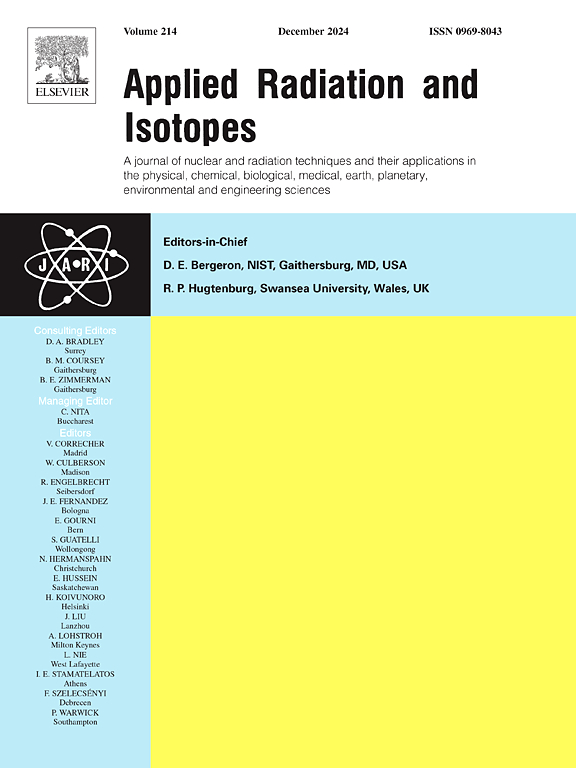Radon in water measurements by sampling with sunflower oil
IF 1.6
3区 工程技术
Q3 CHEMISTRY, INORGANIC & NUCLEAR
引用次数: 0
Abstract
A novel method for measuring radon in water is proposed. This method involves sampling radon from water into sunflower oil and subsequently measuring the radon in the oil using either Cherenkov counting or Liquid Scintillation (LS) counting. The high partition coefficient of radon between oil and water enables radon preconcentration in the oil, significantly improving the Minimum Detectable Activity Concentration (MDAC) compared to direct Cherenkov or LS measurements in water. The estimated MDACs for the method are 0.20 Bq/l using Cherenkov counting and 0.04 Bq/l using gross alpha/beta LS counting.
The MDAC achieved with Cherenkov counting allows for radon-in-water measurements for the purposes of radiation protection, ecology, hydrology, and earth sciences without requiring LS cocktails.
The MDAC for LS counting facilitates radium-in-water measurements (via radon measurement) for radiation protection without chemical pretreatment of the water sample.
Additionally, the method enables direct estimation of the radon partition coefficient between water and oils. The partition coefficient of radon between sunflower oil and water at 20 °C is estimated at Koil/w = 23.2(16).
用葵花籽油取样测量水中氡
提出了一种测量水中氡的新方法。这种方法包括将氡从水中取样到葵花籽油中,然后使用切伦科夫计数或液体闪烁计数来测量油中的氡。氡在油和水之间的高分配系数使氡在油中预先富集,与直接在水中进行Cherenkov或LS测量相比,显著提高了最低可检测活性浓度(MDAC)。该方法的估计MDACs使用切伦科夫计数为0.20 Bq/l,使用总α / β LS计数为0.04 Bq/l。用切伦科夫计数实现的MDAC允许用于辐射防护、生态学、水文学和地球科学目的的水中氡测量,而不需要LS鸡尾酒。用于LS计数的MDAC便于水中镭测量(通过氡测量),用于辐射防护,而无需对水样进行化学预处理。此外,该方法可以直接估计水和油之间的氡分配系数。在20℃时,氡在葵花籽油和水之间的分配系数估计为Koil/w = 23.2(16)。
本文章由计算机程序翻译,如有差异,请以英文原文为准。
求助全文
约1分钟内获得全文
求助全文
来源期刊

Applied Radiation and Isotopes
工程技术-核科学技术
CiteScore
3.00
自引率
12.50%
发文量
406
审稿时长
13.5 months
期刊介绍:
Applied Radiation and Isotopes provides a high quality medium for the publication of substantial, original and scientific and technological papers on the development and peaceful application of nuclear, radiation and radionuclide techniques in chemistry, physics, biochemistry, biology, medicine, security, engineering and in the earth, planetary and environmental sciences, all including dosimetry. Nuclear techniques are defined in the broadest sense and both experimental and theoretical papers are welcome. They include the development and use of α- and β-particles, X-rays and γ-rays, neutrons and other nuclear particles and radiations from all sources, including radionuclides, synchrotron sources, cyclotrons and reactors and from the natural environment.
The journal aims to publish papers with significance to an international audience, containing substantial novelty and scientific impact. The Editors reserve the rights to reject, with or without external review, papers that do not meet these criteria.
Papers dealing with radiation processing, i.e., where radiation is used to bring about a biological, chemical or physical change in a material, should be directed to our sister journal Radiation Physics and Chemistry.
 求助内容:
求助内容: 应助结果提醒方式:
应助结果提醒方式:


